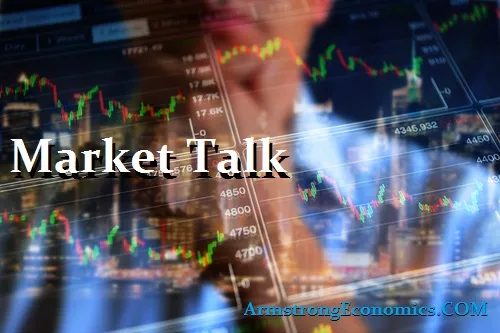Asia:
Recent figures show that Chinese trade with the U.S. has slumped. The figures suggest that the trade between the two countries is down 11% since the beginning of the year. China’s own internal figures are good with the country exporting 14% more in March and imports falling 7%, further increasing their trade balance.
The latest from the US-China trade agreement is that China would have to adhere to strict measures in order to prohibit currency manipulation. The Chinese government has often been accused of manipulating the Chinese yuan to keep the yuan artificially low by increasing the supply on the international markets. They manage to do this by buying USD, thus increasing the demand for dollars whilst supplying the international markets with Chinese yuan. Therefore, they have made Chinese goods cheaper and more attractive for exports.
In Canada, a parliamentary committee provided evidence that Chinese spies and agents are currently active in the country. They state that they are working towards promoting pro-Chinese positions within and amongst the members of parliament.
Last week, a report from the Asia Times suggested the BOJ has restructured to become more like a “hedge fund.” The BOJ balance sheet has now surpassed 4.9 trillion USD, which is larger than the country’s GDP. BOJ has been known to be a huge player in the Japanese domestic bond markets, taking over 50% of the existing securities. Now they are shifting focus to securities, hence making them more like a hedge fund.
Most of the major Asian stock markets had a green day today: SENSEX increased 160.10 points (0.41%) to 38,767.11, NIKKEI 225 increased 159.18 points (0.73%) to 21,870.56, Hang Seng increased 70.31 points (0.24%) to 29,909.76, KOSPI increased 9.01 points (0.41%) to 2,233.45, ASX 200 increased 52.60 points (0.85%) to 6,251.30. However, Shanghai took the opposite route and decreased 1.34 points (-0.04%) to 3,188.63.
The major Asian currency markets had a mixed day today: The AUDUSD increased 0.0054 or 0.76% to 0.7177, the NZDUSD increased 0.0046 or 0.68% to 0.6772, and the USDJPY increased 0.3550 or 0.32% to 112.0050. The USDCNY took the opposite route and decreased 0.0177 or 0.26% to 6.7089
Gold decreased 0.39 USD/t oz. or -0.03% to 1,290.01 and Silver increased 0.0565 USD/t. oz or 0.38% to 15.0110.
Some economic news from late evening yesterday:
South Korea:
- Export Price Index (YoY) (Mar) increased from -2.5% to -0.5%
- Import Price Index (YoY) (Mar) increased from 3.5% to 4.3%
New Zealand:
- Business NZ PMI (Mar) decreased from 53.7 to 51.9
- Electronic Card Retail Sales (YoY) (Mar) decreased from 3.4% to 0.7%
- Electronic Card Retail Sales (MoM) (Mar) decreased from 0.6% to -0.3%
- External Migration & Visitors (Feb) decreased from 5.3% to -1.3%
- Permanent/Long-Term Migration (Feb) increased from 6,100 to 6,570
- Visitor Arrivals (MoM) decreased from -0.3% to -1.5%
Singapore:
- GDP (QoQ) (Q1) increased from 1.4% to 2.0%
- GDP (YoY) (Q1) decreased from 1.9% to 1.3%
- URA Property Index (QoQ) (Q1) decreased from 0.50% to -1.50%
Some economic news on Friday:
Singapore:
- Retail Sales (MoM) (Feb)
- Retail Sales (YoY) (Feb)
China:
- Exports (YoY) (Mar) increased from -20.8% to 14.2%
- Imports (YoY) (Mar) decreased from -5.2% to -7.6%
- Trade Balance (USD) (Mar) increased from 4.08B to 32.65B
- M2 Money Stock (YoY) (Mar) increased from 8.0% to 8.6%
- New Loans (Mar) increased from 885.8B to 1,690.0B
- Outstanding Loan Growth (YoY) (Mar) increased from 13.4% to 13.7%
India:
- Bank Loan Growth decreased from 14.5% to 13.2%
- Deposit Growth remain the same at 10.0%
- FX Reserves, USD increased from 411.91B to 413.78B
- CPI (YoY) (Mar) increased from 2.57% to 2.86%
- Cumulative Industrial Production (Feb) decreased from 4.4% to 4.0%
- Industrial Production (YoY) (Feb) decreased from 1.4% to 0.1%
- Manufacturing Output (MoM) (Feb) decreased from 1.0% to 0.3%
Europe:
The UK and the EU have now agreed to delay Brexit deadline until 31st of October – well past the June 30 extension that had been floated. This should give ample time for a deal to materialize, but who knows. The EU reiterated that this time should not be used wastefully in what are pretty embarrassing circumstances for the UK government. UK politician Nigel Farage, who will be our guest speaker at the next WEC (in Rome), has initiated a new “Brexit Party.” Although he stressed that the mandate will be similar to that of UKIP, its nature will be completely different. He was unhappy with the way UKIP was tarnished by far-right members and does not want the new party to promote intolerance. Farage speaking in the UK today stated, “I said that if I did come back into the political fray it would be no more Mr. Nice Guy, and I mean it.”
The EU and US trade agreement, which was initiated last year, is due to commence formal talks on Monday. There are a few issues to work through such as the US completing the Transatlantic Trade and Investment Partnership (TTIP). France is leading the charge of opposing the proposal due to the US not adhering to the Paris climate agreement. Officials said there are some concerns regarding agriculture and the process could take a while as the US is still in talks with China.
The major European stock markets had a green day today: CAC 40 increased 16.99 points or 0.31% to 5,502.70; the FTSE 100 increased 19.11 points or 0.26% to 7,437.06, and the DAX increased 64.73 points or 0.54% to 11,999.93.
The major European currency markets had a mixed day today: The EURUSD increased 0.00482 or 0.43% to 1.12982 and the GBPUSD increased 0.0034 or 0.26% to 1.3088. The USDCHF took the opposite route and decreased 0.0008 or 0.08% to 1.0022
Some economic news from Europe:
Germany:
- German WPI (YoY) (Mar) increased from 1.6% to 1.8%
- German WPI (MoM) (Mar) remain the same at 0.3%
Span:
- Spanish CPI (MoM) (Mar) increased from 0.2% to 0.4%
- Spanish CPI (YoY) (Mar) increased from 1.1% to 1.3%
- Spanish HICP (MoM) (Mar) increased from 0.2% to 1.4%
- Spanish HICP (YoY) (Mar) remain the same at 1.3%
Eurozone:
- Industrial Production (YoY) (Feb) increased from -0.7% to -0.3%
- Industrial Production (MoM) (Feb) decreased from 1.9% to -0.2%
U.S./Americas:
Wall Street had a fairly strong day today, given recent struggles to stay positive. The Dow gained 269.25 points (+1.03%), closing at 26,412.30 – driven in large part by The Walt Disney Company. The S&P 500 increased +0.66%, surpassing 2,900 for the first time in six months (2,907.41 close). The Nasdaq rose +0.46%, closing at 7,984.16. The Russell 2000 finished up +0.36%, closing at 1,584.80.
Yesterday in an investor day session, Disney unveiled more details around its previously announced direct-to-consumer streaming service, dubbed Disney +. The advertising-free service will be priced at $6.99 per month, or $69.99 pear year. As more households opt to cut cable in favor of streaming services, subscription-based streaming platforms are on the rise. Although Disney+ will face an uphill battle against the likes of Netflix, Disney has an unparrallleld portfolio of content that has been enhanced over the years with strategic acquisitions of Pixar, Marvel, Lucasfilm (Star Wars), and most recently 20th Century Fox (which also gives Disney a controlling stake in Hulu). Disney CEO Bob Iger made clarified the split in target audiences across their services: “If consumers want sports, they can subscribe to ESPN+. If they want adult content, they can subscribe to Hulu, and if they want family, there’s Disney+.”. Investors seem to like the idea now that pricing and user estimates were announced, sending Disney’s stock up +11.54% on the day.
Meanwhile, JPMorgan Chase stock rose +4.53% today after the company announced a better than expected first quarter. Shareholders earned 16% return on their investments during Q1. On a YoY basis, the bank’s profits are up 5%, largely in part to the Federal Reserve’s higher interest rate revision. CEO Jamie Dimon optimistically stated that U.S. economic growth “can go on for years.” He cited the pending U.S.-China trade deal as an area that could impact short-term economic growth, but stated he does not foresee a coming recession.
Anadarko Petroleum Corp. stock soared over 32% today after Chevron announced a new acquisition deal to the tune of $33 billion. The acquisition will place Chevron on the same playing field as oil giants Exxon Mobil Corp. and Royal Dutch Shell Plc. It is estimated that the combined companies produced an output of 3.596 million barrels of oil per day during 2018, which is close to Shell’s 3.666 million barrels and Exxon’s average of 3.833 million barrels. Shareholders of Anadarko will receive 0.3869 shares of Chevron in addition to $16.25 cash per share.
In an interview with the New York Times, Canadian Finance Minister Bill Morneau voiced concerns over current U.S.-imposed tariffs on Canadian aluminum and steel. Morneau cited that the tariffs could post a threat to the entire North American Free Trade Agreement. Tariffs on Canadian steel imports are currently at 25%, while aluminum is at 10%. The U.S. has stated that they are potentially willing to cut tariffs in exchange for a quota agreement on steel and aluminum exports to the U.S.
The USD Index decreased -0.22% this Friday (last reading 96.96). The USDCAD declined -0.40% (last reading 1.333).
The Canadian markets traded in positive territory this Friday. The TSX Composite increased by 81.06 points or +0.49%, closing at 16,480.53. The TSX 60 gained 5.53 points or +0.56%, closing at 984.66.
Brazil’s Bovespa continued to slip further below its March high after decreasing for the fourth consecutive day. The index lost -1,878.06 points today, closing at 92,876.64 (-1.98%).
Energy:
Exxon Mobile announced today that they are concerned with the quality of crude it purchased from the US strategic Petroleum Reserve. Exxon is complaining that the crude contained very high levels of toxic hydrogen sulfide. The US government has disputed the claims.
In other news, President Trump seems to have Iran in his scope. Last week, he called the nation’s guard “terrorists” and yesterday he stated that he wishes to drive Iran’s crude exports to zero. The existing waiver of sanctions is up for renewal soon, with Trump perhaps unlikely to do so. The issue Trump faces with applying further sanctions on Iran are that he will inevitably reduce the international crude supply and therefore increase prices. This would put victory with the OPEC group and Russia. The Iranian leader stated if sanctions are imposed, Iran will continue to sell their supplies – and would probably be successful in doing so given the lack of supply.
Most of the oil markets had a green day today. Crude oil increased 0.7 USD/BBL or 1.10% to 64.2035; Brent increased 1 USD/BBL or 1.41% to 71.9759; Gasoline increased 0.0144 USD/GAL or 0.71% to 2.0473; and Heating oil increased 0.0079 USD/GAL or 0.38% to 2.0753. However, natural gas took the opposite route decreased 0.005 USD/MMBtu or -0.19% to 2.6569.
Top commodity gainers were Oat (2.68%), Lumber (2.64%), Cotton (2.03%). The biggest losers were Ethanol (-0.52%), Coffee (-0.22%), Naphtha (-1.17% by Apr/11), and Rhodium(-1.15% by Apr/11).
The above data was collected around 14:02 EST on Friday.
Bonds:
Japan -0.06%(-0bp), US 2’s 2.39% (+6bps), US 10’s 2.55%(+7bps), US 30’s 2.97%(+7bps), Bunds -0.01% (+3bp), France 0.40% (+8bp), Italy 2.55% (-1bp), Turkey 17.55% (+7bp), Greece 3.29% (-5bp), Portugal 1.17% (+3bp), Spain 1.05% (+3bp) and UK Gilts 1.21% (+10bp).






